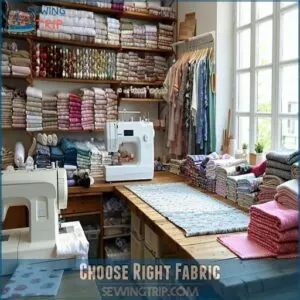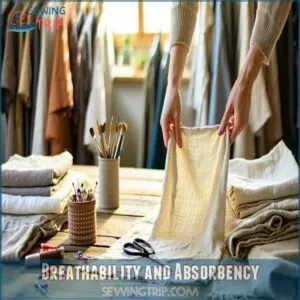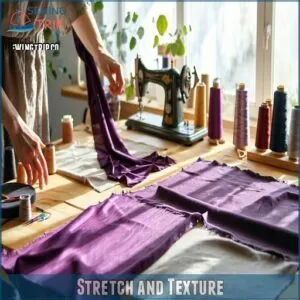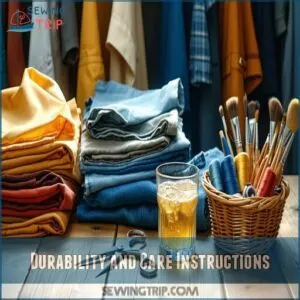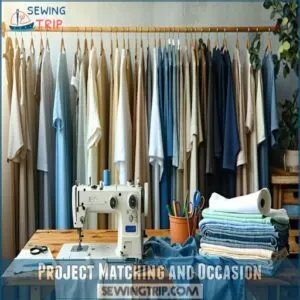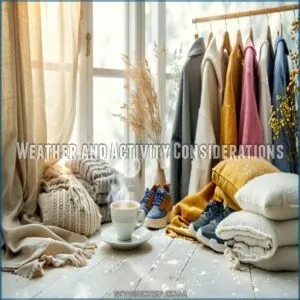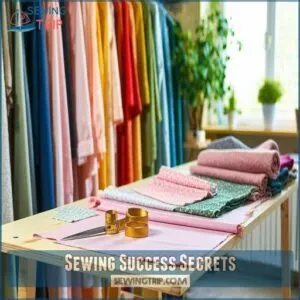This site is supported by our readers. We may earn a commission, at no cost to you, if you purchase through links.
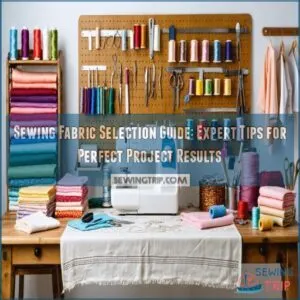
Your sewing fabric selection guide starts with understanding basics: natural fabrics like cotton bring breathability, while synthetics offer durability.
Think about weight too – lightweight chiffon flows like a summer breeze, while heavyweight denim stands strong.
You’ll want to match your fabric to your project: flowing dresses love fluid drapes, while structured suits need wrinkle-resistant materials.
Don’t forget to check care instructions – some fabrics are low-maintenance friends, while others need special handling to stay gorgeous.
And wait until you discover the secrets of pre-washing!
Table Of Contents
Key Takeaways
- You’ll need to match your fabric’s properties to your project – lightweight fabrics like chiffon work best for flowing dresses, while heavyweight materials like denim are ideal for structured pieces.
- You’re better off understanding both natural and synthetic fibers – natural fabrics offer breathability and comfort, while synthetics provide durability and easy maintenance.
- You’ll want to pre-wash your fabric before starting your project to prevent unwanted shrinkage and ensure your finished piece maintains its intended size and shape.
- You should start with medium-weight cotton if you’re a beginner – it’s forgiving, easy to handle, and versatile enough for various projects while you master basic techniques.
Choose Right Fabric
You’ll feel like a fabric-picking pro once you understand how different materials work for your sewing projects.
From cozy cotton to luxurious silk, whether you’re making a summer dress or winter coat, knowing your fabric’s weight, stretch, and care needs will save you from those "what was I thinking" moments at your sewing machine.
Fabric Types and Characteristics
When you’re diving into sewing, understanding fabric texture and weave patterns is like learning a new language.
You’ll encounter fabric types ranging from soft cotton to luxurious silk, each with unique yarn composition and characteristics.
Natural fabrics like linen breathe beautifully, while material sourcing for synthetic options gives you durability.
To explore various types of fabric, consider the properties that suit your project needs.
Get familiar with fiber blending too—it’s how fabrics achieve that perfect balance of properties you’re after.
Natural and Synthetic Fibers
From cotton fields to science labs, the field of textile science offers endless fabric possibilities.
Understanding natural and synthetic fibers helps you make smarter choices for your projects.
Here’s what makes each fiber type unique:
- Natural fabrics like cotton, silk, and wool offer excellent breathability and comfort
- Synthetic fabrics such as polyester and nylon provide durability and easy care
- Eco fabrics made from recycled materials support sustainable sewing
- Fiber blends combine the best qualities of both worlds
- Material sourcing affects both quality and environmental impact
When selecting fabrics, consider the breathability factor to guarantee the best performance for your project.
Fabric Weight and Drape
The fabric weight and drape can make or break your sewing project.
Understanding the fabric drape guide is important for selecting the right textile for your needs.
Light fabrics (4-7 oz) like chiffon float beautifully, while heavyweight textiles (11-14 oz) like denim hold structure perfectly.
Check the GSM (grams per square meter) to understand fabric density.
Test the textile flow by draping it over your hand – if it falls in soft fabric folds, it’s perfect for flowing dresses and skirts.
Fabric Properties Matter
You’ll be amazed at how much fabric properties can make or break your sewing project, just like picking the wrong shoes for a marathon.
When you’re choosing fabric, you’ll need to evaluate key features like stretch, breathability, and durability to guarantee your finished piece looks and feels exactly how you want it.
Breathability and Absorbency
Understanding fabric breathability means picking materials that’ll keep you comfy in any weather.
Natural fabrics like cotton and linen offer excellent moisture management and air circulation, while synthetic blends can trap sweat.
When selecting fabrics, check their porosity – hold them up to light to gauge air flow.
The breathable fabrics list includes various materials with unique properties.
Proper thermal regulation matters too – you don’t want your summer dress feeling like a sauna suit!
Stretch and Texture
Beyond breathability, your fabric’s stretch and texture make or break your sewing project.
When checking fabric stretch, give it a gentle pull – knit fabrics offer that comfy 2-way or 4-way stretch, while woven fabrics stay more structured unless they’re blended with spandex. Understanding stretchy knit properties can greatly impact the overall fit and comfort of your final product.
- Run your fingers over velvet’s plush surface – it’s like petting a cat backwards
- Feel how silk slides through your hands like water
- Notice how canvas stands firm like a soldier on duty
- Listen to taffeta’s subtle whisper when you bunch it up
Durability and Care Instructions
Your fabric’s lifespan depends on how you treat it from day one.
Test durability through abrasion, pilling, and tear resistance checks before starting your project.
Following care instructions isn’t just about keeping things clean—it’s about preserving your hard work.
Prewash natural fibers, separate colors, and store pieces flat to prevent damage.
For delicate fabrics like silk or wool, gentle handwashing or dry cleaning is your best friend.
Select Fabric Wisely
You’ll save yourself countless headaches by choosing the right fabric for your project, just like you wouldn’t wear a wool sweater to the beach.
Whether you’re making a summer dress or cozy winter coat, matching your fabric to your project’s needs will make the difference between a piece you’ll treasure and one that’ll end up at the bottom of your craft drawer.
Project Matching and Occasion
Matching fabric to your sewing project isn’t just about picking pretty patterns.
For flowy dresses, choose lightweight fabrics with fluid drape.
Structured suits need wrinkle-resistant materials that hold their shape.
Cotton and linen make perfect breathable tops, while silk shines in formal blouses.
Got jeans on your to-do list? Grab denim for its durability.
Understanding fabric properties is key to making informed decisions about the best fabric for your project.
Remember, wool’s your best friend for sophisticated trousers and dress pants.
Weather and Activity Considerations
Beyond the perfect occasion fit, think about when and how you’ll wear your creation.
Summer fabrics like lightweight linen keep you cool, while winter fabrics need that cozy warmth.
For activewear, pick performance materials that wick sweat and move with you.
Heading outdoors? Look for outdoor fabrics with water resistance and extra durability.
Match fabric breathability and weight to the activity’s demands.
Wearer and Skill Level Factors
Three key factors shape your fabric selection: who’ll wear it and your sewing confidence.
Consider age appropriateness when picking fabrics – cotton for kids’ wear, silk for adult formal attire.
As your sewing confidence grows, tackle advanced challenges like slippery silks or stretchy knits for complex sewing projects, starting with medium-weight cotton if you’re new to sewing, to build your sewing confidence.
Care and Maintenance Tips
You’ll save yourself from those dreaded "my favorite shirt shrunk" moments when you know how to properly care for your fabric before and after sewing.
Whether you’re working with delicate silk or sturdy denim, understanding the right washing, drying, and storage techniques will keep your handmade creations looking fresh and fabulous for years to come.
Pre-Washing and Shrinkage Prevention
Since fabric shrinkage can turn your perfect-fit creation into a disappointment, pre-washing is your secret weapon against unwanted surprises.
You can purchase fabric shrinkage test products.
Here’s your pre-wash game plan:
- Test a fabric shrinkage swatch first – cut a 4-inch square, mark measurements, then wash and dry
- Pre-wash fabric using the same method you’ll use for the finished piece
- Iron while slightly damp to minimize shrinkage and maintain fabric shape
Washing and Drying Instructions
The right water temperature can make or break your fabric care routine.
For everyday items, warm water works best with gentle detergent types, while delicates need cold water care.
Use hot water and stain removal products for whites and heavily soiled items.
Regarding drying cycles, adjust the heat based on fabric care instructions – cotton can handle regular cycles, but delicates need gentler treatment.
Ironing and Storage Techniques
Now that your fabric’s clean, let’s keep it looking sharp with proper ironing and storage techniques.
Following fabric care tips helps extend your materials’ life and prevents frustration when you’re ready to sew.
- Store delicate silks rolled in acid-free tissue to avoid permanent creases
- Cool iron wool with a pressing cloth to prevent shine
- Fold sturdy cottons along grain lines for wrinkle-free storage
- Stack fabrics flat in a dark, dry space using fabric storage boxes
Remember to check ironing instructions on fabric labels – different fibers need different heat settings.
Sewing Success Secrets
You’ll find that mastering sewing isn’t just about perfect stitches – it’s about smart preparation and knowing the little tricks that make every project smoother.
Whether you’re wrestling with stubborn fabric or trying to keep your sewing space organized, these time-tested secrets will help you tackle common challenges and create beautiful results.
Troubleshooting Common Sewing Issues
Spotting tension issues early saves hours of frustration later.
When you notice uneven stitches or thread breakage, check your machine’s threading and adjust tension settings for your fabric type.
Machine jams often stem from improper threading or bobbin debris, while fabric tears typically result from using the wrong needle size.
Remember: quality thread and correct tension settings prevent most common sewing errors and keep your projects running smoothly.
Organization and Time Management Tips
A tidy Sewing Space isn’t just pretty – it’s your ticket to faster projects.
Try Time Blocking to maximize your sewing sessions and sort fabrics by weight or project type.
Smart Project Planning means keeping your tools handy and fabrics visible. Consider sewing room organization ideas to maximize efficiency and inspiration.
Set realistic goals for each session, whether it’s pinning patterns or finishing seams. Remember, fabric selection tips work best when you’ve got an organized setup to work with.
Frequently Asked Questions (FAQs)
What are the different types of fabric?
You’ll find cotton for breathability, linen for summer wear, wool for warmth, silk for luxury.
You’ll also find polyester for durability, velvet for elegance, felt for crafts.
Canvas is available for strength, and denim for rugged projects.
How do I choose a fabric for a sewing machine?
Like picking the perfect dance partner, select medium-weight cotton or linen for your first sewing projects.
You’ll want fabrics that aren’t too stretchy or slippery while you’re learning your machine’s rhythm.
Which fabric should a beginner sew?
Start with medium-weight cotton fabrics – they’re forgiving, easy to handle, and perfect for mastering basic techniques.
You’ll love how they don’t slip or stretch while you’re learning to control your machine.
What is a good fabric for sewing?
Cotton’s your best bet – it’s sturdy yet forgiving, perfect for learning.
You’ll find it easy to work with and won’t break the bank.
Plus, it’s versatile enough for everything from quilts to clothes.
What type of yarn is best for sewing?
For your sewing projects, you’ll want strong polyester or cotton thread that matches your fabric weight. Heavy fabrics need thicker thread, while lightweight materials work best with finer options.
How do I choose a fabric for a nursery?
Select soft, washable fabrics like cotton or fleece for your nursery.
You’ll want lightweight, breathable materials for comfort, and durable ones for spills.
Pre-wash everything to prevent shrinkage and allergic reactions.
How to match thread weight with fabric type?
Just as you wouldn’t wear flip-flops to climb a mountain, you’ll want to match your thread weight to your fabric’s bulk.
Use lightweight thread for delicate fabrics, medium for everyday cottons, and heavy-duty for denim.
Where to find accurate fabric yardage calculators online?
You’ll find reliable calculators at Sailrite’s website for precise project estimates.
These calculators, including those for backing, binding, and borders, are also offered by Quilter’s Paradise as trusted free calculators.
Robert Kaufman Fabrics provides essential quilting calculators too.
Can different fabrics be mixed in projects?
While mixing fabrics might seem tricky, you can absolutely blend different materials in your projects.
Choose fabrics with similar weights and care requirements, and you’ll create unique combinations that work beautifully together, using similar weights.
Which interfacing works best for specific fabrics?
For lightweight fabrics, use fusible web interfacing. Medium-weight fabrics need woven fusible interfacing. Heavy fabrics pair best with non-woven sew-in interfacing. Match the interfacing weight to your fabric’s properties.
Conclusion
Like threading a needle on your first try, mastering fabric selection becomes second nature with practice.
Your sewing fabric selection guide journey doesn’t end here – it’s just the beginning of creating stunning projects that’ll make you proud.
Remember to match your fabric to your project’s needs, always pre-wash when needed, and trust your instincts.
With these tips in your toolkit, you’re ready to tackle any sewing challenge that comes your way. Happy sewing!
- https://sewing.com/fabric-types-everything-you-need-to-know/
- https://www.sewessential.co.uk/blog/how-to-choose-the-right-fabric/
- https://picocleaners.com/the-12-different-types-of-fabric/
- https://icefabrics.com/blogs/news/factors-to-consider-when-choosing-a-fabric
- https://www.moodfabrics.com/blog/how-to-choose-the-right-fabric-for-your-project/

